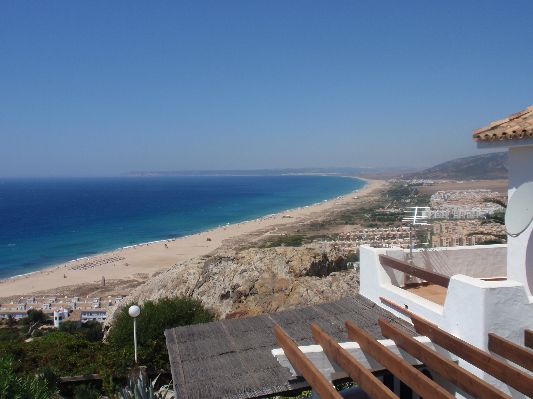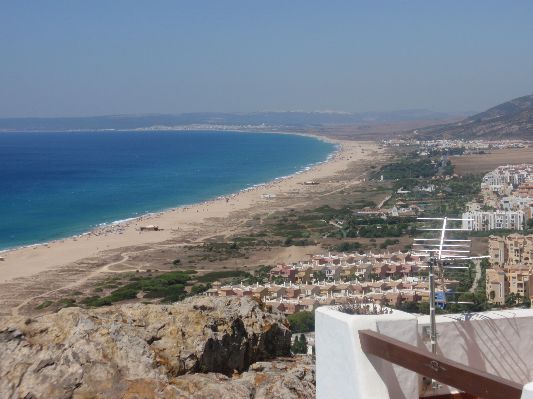
Here you can see the Cape of Trafalgar, at the top and to the left of the picture; to its right is Barbate --beside the beach and, on the top of the mountain, is Vejer--.

Here you can see Barbate closer. Also, you can see Vejer, on the top of the mountain.And, just in the right side of the picture, under a piece of another mountain, the village of Zahara de los Atunes.
When you arrive to Barbate, just in the first roundabout, you have turn to the right and you will drive just beside a gas station and a hipermarket of LIDL.Then, you have to follow the little road and, when you arrive to the famous "Barca de Vejer", close it there is an entrance to Vejer; but I recommend you to take the next one --3 or 4 Kms from there, more or less--.The entrance is on the left side.
.JPG)
When you go up to the top of the village, you can see the main square.
.JPG)
Here you can see the square closer.
.JPG)
This fountain is a replica of the fountain in the square "Plaza Alta" in Algeciras --although this square in Vejer is smaller--.
.JPG)
This is a tipycal narrow street close the square.Through this street you go down, because it starts close the square, which is at the top of the village.
.jpg)
Picture by F.Vargas, in flick.r
This statue is a tribute to the ladies from Vejer, because, till a short time ago, they dressed with a dark dress, from the head to the feet --there fore, they were named "Las Cobijadas" (Cobijar = to take shelter)--.Although Vejer was conquered by arabian people, more than 700 years ago, it has not lost the arabian features.In fact, till a short time ago, women dressed with clothes similar than the ones used in Middle East.Actually, Vejer is twinned with the arabian town named Ched-Chauen.
Vejer was populated from the Paleolithic and it was already fortifyed in the Bronze Age.In pre-Roman period it was named Besaro and they have been found remains from Century VII a.C.under the actual walls.While the Roman period, it changes to be named Baesippo.
In 711, it stayied in Muslim´s hands, after "Janda´s Battle". in which Muslimsk, lead by Tarik, defeated to Don Rodrigo.
During half and five Centuries, it stayied under the Muslim´s control, taken the name Besher.Stay traces like the door of the Castle (Century XI), part of the walls and the network of its streets.Vejer came back to Christian hands twice.The first one, in 1250, reigning Fernando III "The Saint", and it came back to arabian hands in June of 1264, after an uprising in which they took the Castle by force.
The second one and the definitive, started in August of 1264, expeling to Mudejars and it finished in 1285.Just that year, Sancho IV gave to the Order of Santiago the dominion on Vejer in order to consolidate the territory in a faster way, although that Order never took possession of Vejer.
In 1307, after a second repopulation, it came to be a dominion of Guzman El Bueno. who, since 1299, was thw owner of the dominion of Las Almadrabas of evry are in the Strait of Gibraltar, and after took Tarifa, he bacame himself defending of the Strait, becoming to be the owner and gentleman, after the King, of these lands.From him, will inherit the duchess of Medina Sidonia.
During the Centuries XV and XVI, Vejer was under the control of the Guzmanes, and already in the Modern Age, people faced, with Juan Relinque at the head, against the Duchess of Medina Sidonia, by the control of the communal lands, named "Hazas de suerte".
Vejer was declared Historical Site, in 1976.